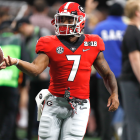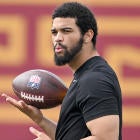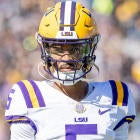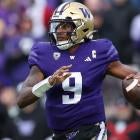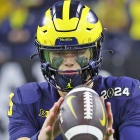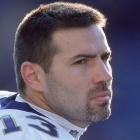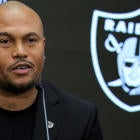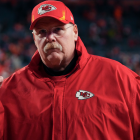Sony Michel proved the value of selecting a running back in the first round.
Michel, the 31st overall pick in last year's draft, showed his worth during the 2018 playoffs. In three playoff games, Michel, a standout at the University of Georgia, rushed for 336 yards while averaging 4.7 yards per carry. He also scored six touchdowns that included the only touchdown scored in New England's victory over Los Angeles in Super Bowl LIII.
While throwing the ball may be the primary mode of attack in today's NFL, Michel and the Patriots proved last year that an elite rushing attack in the postseason can still be the difference between winning and losing a Super Bowl.
Below are the running backs that are looking to benefit off of Michel's success in the 2020 NFL draft. Fans of NFL teams that are in need of a running back should keep an eye on these players throughout the 2019 college football season.
Cream of the crop
D'Andre Swift, Georgia
NFL Comparison: LeSean McCoy
Herschel Walker. Terrell Davis. Todd Gurley. Garrison Hearst. Nick Chubb. Sony Michel. These are the Georgia running backs D'Andre Swift will look to emulate as he prepares to enter the 2020 NFL draft.
Michel's former teammate at Georgia, Swift rushed for a team-high 1,049 yards and 10 touchdowns last season. He also caught 32 passes for 297 yards receiving and three touchdowns while helping the Bulldogs finish the season with another 11-win season.
A tremendous cutback runner, Swift can literally cut on a dime while leaving defenders in his wake. He is also blessed with impressive power that has allowed him to literally carry defenders into the end zone. Swift's elusiveness, closing speed and ability to run between the tackles is also above the line.
In 2019, Swift will look to prove that he carry the load for a second straight year. He recently said that his time playing with Chubb and Michel has helped prepare him for this moment.
"I learned how to carry myself as a pro without even being in the league," he recently told The Draft Network.com. "As one of the leaders on this team, people look up to me now, and I have to make sure that I'm setting the example by doing the right thing, which is what I learned from those two when I was a young player. I gotta lead by example."
Jonathan Taylor, Wisconsin
NFL Comparison: Leonard Fournette
A physical back who put up video-game numbers during his first two collegiate seasons (he rushed for 4,171 yards and 29 touchdowns while averaging 6.9 yards per carry), the 5-foot-11, 219-pound Taylor also is also blessed with deceptive speed that allows him to turn moderate gains into break-breaking plays.
Taylor has been a model of consistency at Wisconsin. Last year, he rushed for at least 100 yards in 12 of the Badgers' 13 games. He had five 200-yard rushing performances that included a 321-yard, three-touchdown effort in the Badgers' triple-overtime victory against Purdue and a 205-yard performance in Wisconsin's bowl victory over Miami.
A classic power back, Taylor does his best work on counter plays with a pulling guard. He is the perfect back for a team that wants to win games at the line of scrimmage behind a powerful and athletic offensive line.
Taylor will have to work on his fumbling issue in 2019, as he put the ball on the ground 12 times during his first two years in Wisconsin. NFL teams may be leery of Taylor's high usage rate in college, something that could work against him when being compared to other backs in next year's draft that will have less wear and tear.
Eno Benjamin, Arizona State
NFL Comparison: Melvin Gordon
A sophomore last season, Benjamin had a breakout 2018, rushing for 1,642 yards and 16 touchdowns while averaging 5.5 yards per carry. A ball of muscle at 5-foot-10 and 201 pounds, Benjamin had nine 100-yard games that included a 312-yard, three-touchdown effort against Oregon. A high-energy player, Benjamin has both speed and power that makes him a threat to go the distance every time he touches the ball.
Benjamin will get a chance to show off his versatility in 2019. ASU head coach Herman Edwards, during Pac-12 Media Day, said that the goal is to get Benjamin 50 receptions this season.
"I've always told quarterbacks, 'Hey, take a profit, throw it to the [running back],'" Edwards said, via 247Sports. '"If he's open, throw it to the back.'
"We want to make first downs, and in our system, he'll be out a lot and we're unleashing him. Eno knows he wants to play at the next level, and the good ones come out of the backfield and catch the ball. That'll give us some good matchups too."
Benjamin will have his work cut out for him in 2019. Wide receiver N'Keal Harry is now with the Patriots, while ASU's offensive line has undergone a considerable overhaul this offseason. The Sun Devils will also have a true freshman under center to start the season.
Ke'Shawn Vaughn, Vanderbilt
NFL Comparison: Alvin Kamara
An Illinois transfer, Vaughn had a breakout in 2018, rushing for 1,244 yards and 12 touchdowns while averaging 7.9 yards per carry during his first season at Vanderbilt. He had five 100-yard rushing performances last season that included four 100-yard games in the Commodores' final five games. He saved his best performance for last, rushing for 243 yards and two scores on just 13 carries Vanderbilt's loss to Baylor in the Texas Bowl.
Vaughn, assuming he will have more than the 157 carries he received last season, should have considerably stronger numbers in 2019. The 5'10, 218-pound Vaughn has excelled in Vanderbilt's zone-blocking scheme while showcasing his superior vision, decision making and ability to quickly find the right running lanes.
While he may not be the country's fastest running back, Vaughn is still more than capable of breaking off long runs. He had several such runs last year that included big runs against Baylor, Florida, Nevada, and Arkansas. Vaughn is also an exceptional goal-line back, as several of his touchdown runs last season came inside the 5-yard-line.
Vaughn's tape on third down is what NFL teams will be keeping an eye on this fall. He will have to prove his worth in pass-catching as well as in pass protection to cement his standing as the first or second running back taken in this year's draft.
Travis Etienne, Clemson
NFL Comparison: Sony Michel
Etienne played a key role in Clemson's 2018 national championship run, rushing for 1,658 yards and 24 touchdowns while averaging a whopping 8.1 yards per carry. In the CFP playoffs, Etienne rushed for 195 yards and three touchdowns on 28 carries in Clemson's victories over Notre Dame and Alabama.
The 5-foot-10, 215-pound Etienne might be the most versatile runner in the country. He can rip off big runs up the middle as well as outside the hash marks. Etienne's greatest strength is his ability to kick it to another gear once he enters the secondary, blowing past defensive backs who thought they had a chance to catch him.
Etienne is also a tremendous decision-maker. While some backs rely on patience, Etienne is an extremely decisive runner who seems to know where he wants to go as soon as he gets the ball. He is also a physical back who doesn't usually go down after first contact.
Receiving is one thing NFL teams may want to see more of from Etienne in 2019, as he enters this season with just 17 receptions during his time at Clemson.
J.K Dobbins, Ohio State
NFL Comparison: Jordan Howard
Currently tabbed as the fifth-best running back prospect by CBSSports.com, Dobbins has rushed for 2,458 yards and 17 scores during his first two seasons at Ohio State while averaging 5.8 yards per carry. Expect Dobbins, whose statistics regressed last season while playing alongside Dwayne Haskins, to thrive with new OSU QB Justin Fields under center. Fields, a dual-threat quarterback, should help open up more running lanes for Dobbins, who should also continue to make plays in the passing game after catching 48 passes during his first two years with the Buckeyes.
Dobbins' showed his value, and versatility, in Ohio State's 2018 road victory over Penn State. With the Buckeyes trailing 13-0 and in need of a spark, Dobbins, with the Nittany Lions applying constant pressure on Haskins, took in a screen pass and rumbled 26 yards into the end zone that gave Ohio State a much-needed score heading into halftime. His four-yard touchdown run at the start of the third gave the Buckeyes the lead, while his 35-yard catch on the first play of the Buckeyes' final drive helped set up Ohio State's game-winning score.
While Ohio State's talent at the running back position may limit his production in 2019, first-year head coach Ryan Day's offense will still give Dobbins plenty of opportunities to make plays as a runner as well as a receiver.
"I think that last year, we got the ball to the perimeter a little bit more in terms of some of the bubble screens and like that," Day said, per The O Zone.net. "We'll continue to build that. The quarterback run is something that we're going to be more involved with again this year. And then we'll see as we continue to build this identity on offense -- because it's going to be different than it was with J.T. [Barrett]. It will be different than it was with Dwayne [Haskins] -- how we continue to do that."
Day 2 players with something to prove...
Cam Akers, Florida State
NFL Comparison: Joe Mixon
After a very promising freshman season, Akers took a step back in 2018, partly because of his offensive line and also because of his tendency to try to finesse defenders as opposed to dropping his shoulder and running through them. Akers, who also fought through a nagging ankle issue last season, is now healthy and ready to prove that he is one of the nation's top backs.
"I think Cam is going back in Cam freshman mode," FSU head coach Willie Taggart recently said of Akers, per 247Sprots. "Actually we don't want it to be the freshman mode, we want it to be better than the freshman mode.
"But also, I think he's matured, and he understood, again, what we went through, and also understands what we've got to do in order to not see that again. I think he's committed to doing that."
Trey Sermon, Oklahoma
NFL Comparison: Le'Veon Bell
The 6-foot, 221-pound Sermon will look to build off of a 2018 season that saw him rush for 947 yards and 12 scores while averaging 5.8 yards per carry. While a crowded backfield may limit Sermon's touches, he should still get plenty of opportunities to make plays in 2019.
Sermon is also a very elusive back who routinely makes plays on the outside. His patience and decision-making are other tangibles that should attract NFL teams in need of a running back.
AJ Dillon, Boston College
NFL Comparison: LeGarrette Blount
A massive back at 6-foot and 250 pounds, Dillion rumbled for 2,697 yards and 24 touchdowns over the past two seasons while averaging 5.1 yards per carry. He had five 100-yard games last year that included a season-high 185 yards against Wake Forest.
Dillion is a classic throwback, Jerome Bettis-style back who relishes getting and dishing out hits. He also has impressive speed that allows him to bounce runs to the outside while scoring on several big plays in 2018. While he is not the most versatile of backs, Dillon is the perfect pick for an NFL team looking for a bruiser that can help get the tough yards for their offense.
Najee Harris, Alabama
NFL Comparison: David Johnson
After patiently waiting his turn, Harris will finally get his chance to be Alabama's primary running back in 2019. Last fall, the 6-foot-2, 230-pound Harris rushed for 783 yards and four scores while averaging an impressive 6.7 yards per carry.
Harris is a shifty, elusive back who can bounce it to the outside with ease. Primarily a North-South runner, Harris' greatest strength might be his motor. He is an extremely competitive athlete who fights for every single yard.
Harris does take a lot of punishment, something that could scare off some NFL teams. Harris would also help his draft stock by busting off more long longs in 2019.
Names looking to make a move...
Kylin Hill, Mississippi State
NFL Comparison: Chris Carson
The 5-foot-11, 215-pound Hill had an impressive season in 2018, rushing for 734 yards and four scores while averaging 6.3 yards per carry. Hill also caught four touchdown passes while showcasing his versatility. While his vision and urgency getting up-field are impressive, Hill should work more on his patience while using his lead blockers more efficiency in 2019.
LeVante Bellamy, Western Michigan
NFL Comparison: Darren Sproles
Arguably the best back in the Mid-American Conference, Bellamy broke out in 2018, rushing for 1,228 yards and six touchdowns while averaging six yards per carry. A small back at 5-foot-9 and 185 pounds, Bellamy is excellent at finding space and getting himself into the open field. Durability will be the thing NFL scouts will be watching at Bellamy looks to duplicate last season's success in 2019.
Reggie Corbin, Illinois
NFL Comparison: Lamar Miller
A year after becoming the first Illinois running back to rush for over 1,000 yards in a season since 2010, Corbin, a home run hitter who averaged 8.5 yards per carry last season, will look to improve his draft stock this season after contemplating coming out following his 2018 campaign.
Anthony McFarland, Maryland
NFL Comparison: Derrick Henry
McFarland, who missed his entire senior season in high school due to a leg injury that also caused him to miss part of his freshman season, finally showed what he could do in 2018. After rushing for over 200 yards against Indiana, he ran circles around Ohio State, gaining 298 yards on the ground on his way to 1,034 yards for the season despite receiving just 131 carries.
Josh Mack, Liberty
NFL Comparision: Marlon Mack
A transfer, the 6-foot, 195-pound Mack led FCS with 1,335 rushing yards in 2017 while scoring nine touchdowns and averaging 5.5 yards per carry. Mack is a classic North-South runner with impressive cutback ability and breakaway speed that allowed him to rip off big runs during his time at Maine. Mack will have to prove this season that he can be as successful against better opponents.













